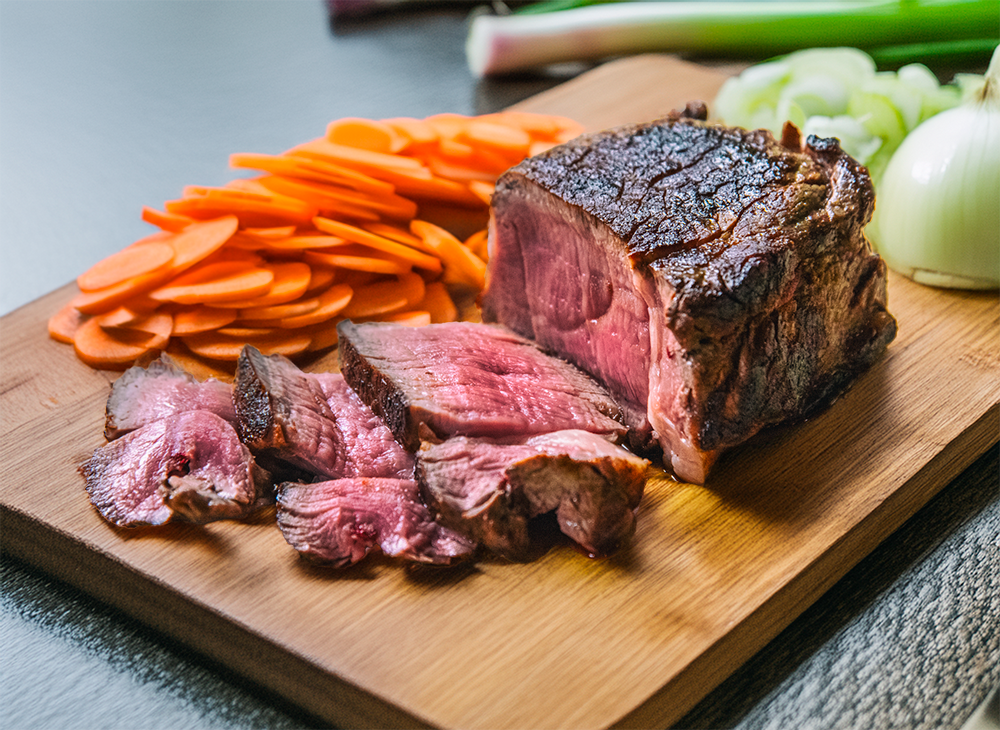Our food system is breaking our soil because our dependence on chemical inputs, like fertilizers, pesticides, and herbicides, has wreaked havoc on our soils.
What’s your beef? The Latest Nutrient Density Research on Pasture-Raised Meat

LeftCoast GrassFed filet mignon.
11/18/2024
By: Kathy Webster and William Milliot
Our food system is breaking our soil
Our dependence on chemical inputs, like fertilizers, pesticides, and herbicides, has wreaked havoc on our soils. Their negative impact on the biology necessary for the process of mineralization (which is how microbes convert minerals into usable nutritional forms for plants) have led to the depletion of critical nutrients in vegetables and livestock forage. This deficiency affects the nutrient pathway from soil to plants, ultimately impacting everyone’s health. To put it another way, 95% of our food comes from soil, and when we don’t have healthy soils, we don’t get nutritious food. Soils are our lifeline.
According to the Food and Agriculture Organization of the United Nations (PDF),
“Soils are the foundation of food production and food security, supplying plants with nutrients, water, and support for their roots. Soils function as Earth’s largest water filter and storage tank; they contain more carbon than all above-ground vegetation, hence regulating emissions of carbon dioxide and other greenhouse gases; and they host a tremendous diversity of organisms of key importance to ecosystem processes.”
Regenerative agriculture works to improve soil
Regenerative agriculture, on the other hand, works towards improving soil health, plant health, livestock health, and human health. To see just how much of a difference beef from a regenerative system has on meat nutrition compared to conventional confined feeding systems, the Bionutrient Food Institute conducted a study in which we were fortunate to participate. Though the Bionutrient Food Institute is not quite ready to show its findings, we’ve been allowed to access and discuss the results.
To participate in the study, we first had to fill out an in-depth survey, which included questions about the breed and age of our cattle, the cattle’s diet, if the cattle were moved and how often, what types of forage they had access to, any supplements we provided, and a host of queries. We also had to provide a range of samples: soil taken one to two months before processing; forage clippings from the various locations where the cattle were feeding in the last 30-60 days before harvest; fecal samples a week before harvest; and finally meat samples from the animals we were monitoring for the study, three Rib Eyes from three different cattle (same herd) in this case.
So far, the results (and they are still researching) indicate that animals that are moved frequently and exposed to phytochemically diverse grasses, forbs, and/or shrubs have higher levels of polyphenols—compounds found in plants that provide potential antioxidant activity—and a host of other nutritional benefits. Mary Purdy, “Eco-Dietitian” and Managing Director of the Nutrient Density Alliance:
“A vast amount of research strongly indicates how these plant chemicals known as “polyphenols” not only protect against cellular damage and disease but also play a crucial role in supporting key physiological functions, including those of the cardiovascular, neurological, endocrine, immune, and reproductive systems. There is growing evidence that pasture-raised or grass-fed cattle produce meat and dairy products that contain higher levels and a broader spectrum of phytonutrients. These nutrients, including various polyphenols, phytosterols and omega-3 fatty acids, are more concentrated in grass-fed animals, and their presence may contribute to improved nutritional outcomes, such as better cardiometabolic health, enhanced immune function, and reduced inflammation. This makes grass-fed meat and dairy potentially more beneficial than conventional products for supporting overall health.”
But what’s truly exciting is that their results are consistent with many studies, as summarized in a recent article by Frederick D. Provenza, Stephan van Vliet, and others.
“Previous studies have found that pasture-finished beef has a higher omega-3 fatty acid and total antioxidant/phenolic content when compared to grain-finished beef. Novel evidence indicates that pasture-finishing of ruminants results in greater accumulation of phytochemicals—phenolics, terpenes, carotenoids and other antioxidant compounds—in meat, which appears directly related to the phytochemical richness of the forage/feed consumed by ruminants. Further, studies of cattle, goats, and sheep on pasture generally report improved markers of animal welfare, especially when ruminants have the ability to select from a diverse mixture of grasses, forbs, and shrubs, and are able to engage in innate behavior.”—Pasture finishing of cattle in Western U.S
The takeaway
The way so much of our food is being produced today has resulted in nutrient-deficient foods and food products that have a growing list of negative consequences for the health of both human and animal consumers. Regenerative agriculture, which focuses on improving and sustaining healthy, biologically robust soils, tends to improve the nutrient levels of foods produced from them. An increasing number of studies, like those conducted by the Bionutrient Food Institute, are being undertaken to explore and quantify the nutrient density of food and its impact on health. That’s why, along with the many other advantages, the likely nutritional benefits are an essential reason for the world to switch to regenerative agriculture.
To support our commitment to improving food’s nutrient density through soil health, we’ve partnered with the Nutrient Density Alliance (NDA), a non-profit dedicated to raising awareness and promoting action around the benefits of regenerative agriculture. NDA’s collaboration aims to better educate the public on healthy soil’s essential role in producing nutrient-rich food. We are excited to be part of it!
What you can do to help
Shop locally and shop wisely. If you can’t “know your farmer,” look for brands that proudly display their commitment to regenerative agricultural practices and feature certifications from organizations like the American Grassfed Association, Fibershed, Regenerative Organic Alliance, Land to Market, and others. Flexing your spending muscle is a powerful way to change the food system.